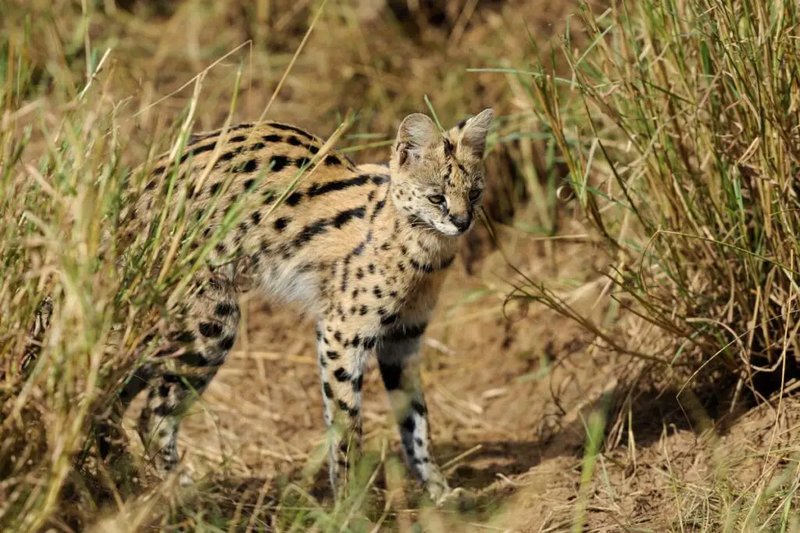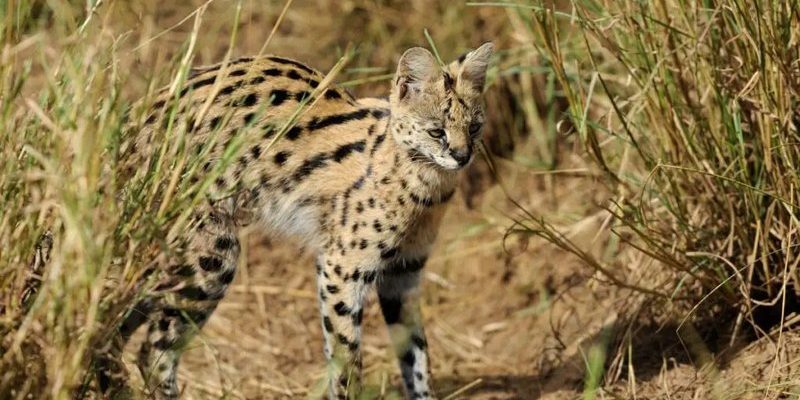
Understanding these similarities not only satisfies curiosity but also broadens our appreciation for the diverse forms of wildlife out there. It can feel a bit like being on a treasure hunt, discovering how different animals connect, and how they each play unique roles in their ecosystems. So grab a cup of coffee, and let’s dive into the world of the serval and its look-alikes.
The Serval: An Overview
Before we dig into the other animals, let’s take a moment to understand the serval itself. Standing about two feet tall at the shoulder, this cat is built for agility. Its long legs give it the ability to see over tall grass and jump impressively high—sometimes up to ten feet to catch birds or rodents mid-flight. With a coat adorned in spots and stripes, the serval blends beautifully with its savanna surroundings.
You might be wondering where you’ll find these stunning creatures. They primarily inhabit sub-Saharan Africa, roaming areas like grasslands, wetlands, and savannas. Thanks to their keen hunting skills and sharp senses, they thrive in these environments. All in all, the serval is an apex predator with a captivating beauty that often gets people asking questions about its relatives.
1. Caracal
First up is the caracal, often mistaken for a serval due to its striking appearance. The caracal shares the same habitats as the serval, primarily found in Africa, the Middle East, and parts of Central Asia. It has those signature tufted ears that stand tall—like little black feathers atop its head.
Think of the caracal as the serval’s close cousin. While both have similar body shapes and color tones, the caracal tends to be a bit stockier and has a shorter tail. Its fur is a reddish-brown, which can sometimes make it hard to tell apart from the serval at first glance. Both cats are superb hunters, but while the serval is famous for its long jumps to catch birds, the caracal uses its stealth and speed on the ground for hunting small mammals.
2. African Golden Cat
Next, we have the African golden cat, which is a bit more elusive than the serval or caracal. Found mainly in the rainforests of West and Central Africa, this cat is smaller and more secretive. It has a beautifully soft, golden-brown coat, which can sometimes confuse those looking for similarities with the serval.
The key difference here is the habitat—while servals prefer open savannas, African golden cats are more at home in dense forests. They also lack the distinctive spots of the serval, making them more uniform in color. Interestingly, these cats are also very good climbers, often seen lounging on tree branches away from predators.
3. Ocelot
Moving from Africa to the Americas, we find the ocelot. This gorgeous cat has a sleek, spotted coat that might remind you of the serval’s patterns. Ocelots are native to South America, but their gorgeous fur and striking features have caught the attention of many animal lovers worldwide.
Ocelots are slightly smaller than servals, but their coloration can be quite similar. A colorful blend of yellows, browns, and spotted patterns can make the two look related at first. However, the ocelot has a more robust build and often lives in forested areas rather than open grasslands. They are also experts at swimming, something that sets them apart from the serval.
4. Margay
The margay is another cat you might confuse with a serval due to its spotted coat. Like the ocelot, the margay is also found in the Americas, primarily in the rainforests of Central and South America. It’s slightly smaller and has a more slender build, which allows it to be an excellent climber.
The margay’s unique ability to reach high branches and leap from tree to tree is quite different from the serval’s style, which focuses more on leaping in open spaces. Its markings are also less distinct than a serval’s, adding to the intrigue of how these cats can look similar yet be quite different in behavior and habitat.
5. Servaline Genet
Now let’s talk about the servaline genet, a small carnivore that shares some similarities with the serval but belongs to an entirely different family—the Genet family. These animals have a long, slender body covered with a spotted coat similar to the serval’s.
The servaline genet can often be found in the same regions as the serval, which adds to the confusion. However, the genet is much smaller and has a long, bushy tail that helps with balance while climbing trees. While the serval is strictly a cat, the servaline genet has some traits like a weasel, making it quite unique in its own right.
6. Clouded Leopard
Clouded leopards are another fascinating animal that shares visual traits with the serval. With their beautiful cloud-like patterns and long bodies, these cats are primarily found in the forests of Southeast Asia. Although they are much larger than servals, their unique markings can create a visual resemblance.
The clouded leopard is known for its climbing skills, often seen resting on tree branches or hunting in the canopy. Unlike the serval, which primarily hunts on the ground, clouded leopards are experts at hunting in the trees, thanks to their long limbs and flexible ankles. You might think of them as the acrobats of the feline world!
7. Lynx
The lynx is a family of medium-sized wild cats found across Europe, Asia, and North America. Although their fur patterns differ, the lynx has a similar ear shape and stature to the serval. They also sport impressive tufts of fur on their ears, which adds to their striking appearance.
Lynxes are known for their excellent hearing, which helps them hunt in snowy environments. Unlike the serval, which is adapted to warmer climates and tall grasses, lynxes are more suited to colder habitats. Their thicker fur coats help them blend into snowy surroundings, making them quite the stealthy hunter.
8. Fishing Cat
Last but not least, we have the fishing cat, which shares the serval’s love of water and hunting prowess. You might find fishing cats in wetlands and swamps throughout South and Southeast Asia. They have a somewhat similar body structure to the serval, but they are generally chunkier.
What sets fishing cats apart is their diet, which primarily includes fish and amphibians. They are also known for their remarkable swimming ability—unlike servals, which are more terrestrial. Their unique adaptations make them a great example of how different environments shape the way animals evolve, while still showcasing some common traits.
—
In conclusion, while the serval is certainly a standout cat with its beautiful spots, long legs, and playful nature, there are many fascinating animals that share similar characteristics. From the tufted ears of the caracal to the unique hunting styles of the fishing cat, each of these animals has its own charm and adaptations that make them a vital part of their ecosystems. The world of wildlife is endlessly interesting, and understanding these relationships helps us appreciate the complexity and beauty of nature just a little bit more. So, the next time you spot a serval or one of its look-alikes, you’ll know a little more about what sets them apart and what they have in common.

